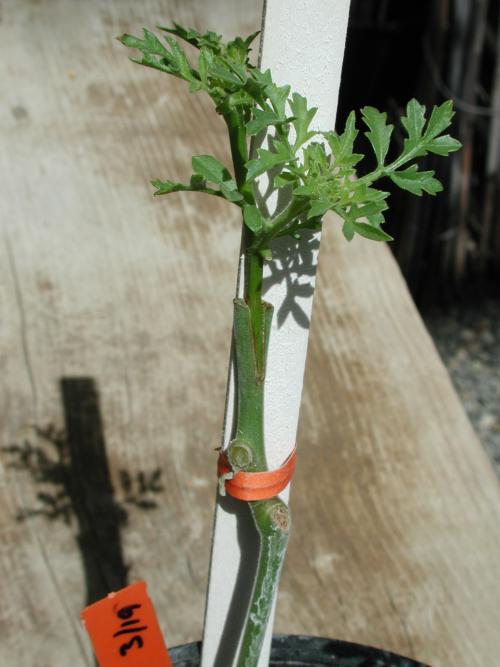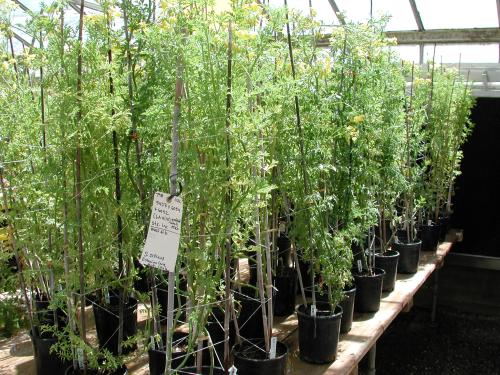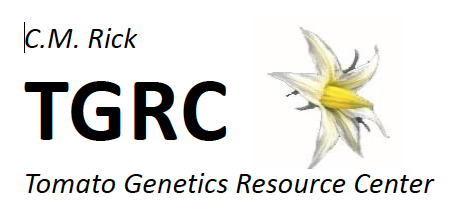Roger T. Chetelat and Jennifer Petersen (2003) TGC Report 53: 14-15
We have struggled over the years to reproduce the tomato-like Solanum species in our collection. S. juglandifolium is difficult because some accessions refuse to flower under our greenhouse conditions, even during short-day regimes which induce other sensitive species. Its close cousin S. ochranthum flowers somewhat more readily, but only after growing so tall that it becomes difficult to handle. Finally, the xerophyte S. sitiens is hypersensitive to soil-borne fungal pathogens, usually brought on by over watering or transplant stress. As a result, many plants succumb before seed can be harvested, resulting in inadvertent selection and loss of genetic diversity in subsequent generations. Our repeated attempts to ameliorate this problem by careful watering, applications of fungicides, or use of specialized soil mixes have met with limited success.
Each of these challenges can be overcome by grafting the nightshades onto a tomato rootstock. Rick (TGC 37:62) used L. esculentum cv. VF36 as a graft rootstock to promote flowering in S. juglandifolium. However, during the time it takes to reproduce this species (up to ~ 2 years), rootstocks would eventually lose vigor or die altogether due to attack by Phytophthora root rot and other diseases. We therefore tested the interspecific hybrid F1 L. esculentum cv VF36 x L. pennellii LA0716 as a potential graft rootstock. This genotype has several advantages for grafting applications. First, the hybrid is amazingly vigorous in its vegetative growth, as anyone who has had the misfortune to include it in a field trial can attest (a single plant will quickly overwhelm rows on either side). Secondly, the L. pennellii parent contributes dominant resistances to multiple races of Fusarium wilt. As a result, roots of the hybrid are either resistant to or can 'outgrow' our common soil-borne diseases, and plants can be maintained indefinitely in pot culture. Thirdly, the hybrid has wide graft compatibility, not only with the Solanum spp. in question, but also with more distantly related Solanaceous crops, such as eggplant (S. melongena) and pepper (Capsicum spp.). Finally, L. pennellii and its hybrid with tomato are daylength insensitive, and flower continuously throughout the year, with relatively few leaves between successive inflorescences (sympodial index = 2 in L. pennellii). Although the hybrid has an annoying tendency to sprout adventitious shoots, these are easily distinguished from scion branches and pruned off.
Standard cleft type grafts (see guidelines below) were made when the rootstock was at the ~4-5 true leaf stage, using stems of roughly the same diameter, from each of the three Solanum spp. Graft unions were wrapped with Nescofilm, and scion branches were pruned to several axillary buds, then enclosed in a Ziploc plastic bag for 10-14 days. Only a small proportion (‹10%) of grafts failed on the first attempt, generally due to a poor match in stem diameter/age, or Botrytis infection. Both graft partners recovered readily from wounding, with shoots of the Solanum spp. becoming woody and strong, and growing vigorously. For S. juglandifolium (LA2120 and LA2788) and S. ochranthum (LA2166 and LA2682), grafts were made starting in early spring, and by July, nearly 100% of plants (4-34 per accession) were flowering. Plants remained more compact and easy to train than ungrafted shoots, continued to flower throughout the year, and set abundant fruit upon cross pollination. Grafts of S. sitiens (LA4105, and LA4110 - LA4114) were made with equal success at various times of the year, and plants flowered prolifically within 1-2 months. Grafted S. sitiens plants were free of the usual root rots, vascular wilts, and other diseases, and produced mature fruit and seed without interference. In light of its positive aspects for grafting, as well as other potential uses, we now maintain seed of the rootstock genotype (LA4135 = VF36 x LA0716) for distribution to interested researchers.


